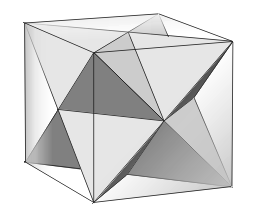2011 AMC 10A Problems/Problem 24
Problem 24
Two distinct regular tetrahedra have all their vertices among the vertices of the same unit cube. What is the volume of the region formed by the intersection of the tetrahedra?
![]()
Solution
The two tetrahedra look somewhat like this.
A regular unit tetrahedron can be split into eight tetrahedra that have lengths of ![]() .
The volume of a regular tetrahedron can be found using base area and height:
.
The volume of a regular tetrahedron can be found using base area and height:
For a tetrahedron of side length 1, its base area is ![]() , and its height can be found using Pythagoras' Theorem. Its height is
, and its height can be found using Pythagoras' Theorem. Its height is  . Its volume is
. Its volume is ![]() .
.
The tetrahedron actually has side length ![]() , so the actual volume is
, so the actual volume is ![]() .
.
On the eight small tetrahedra, the four tetrahedra on the corners of the large tetrahedra are not inside the other large tetrahedra. Thus, ![]() of the large tetrahedra will not be inside the other large tetrahedra.
of the large tetrahedra will not be inside the other large tetrahedra.
The intersection of the two tetrahedra is thus ![]() .
.
See Also
| 2011 AMC 10A (Problems • Answer Key • Resources) | ||
| Preceded by Problem 23 |
Followed by Problem 25 | |
| 1 • 2 • 3 • 4 • 5 • 6 • 7 • 8 • 9 • 10 • 11 • 12 • 13 • 14 • 15 • 16 • 17 • 18 • 19 • 20 • 21 • 22 • 23 • 24 • 25 | ||
| All AMC 10 Problems and Solutions | ||









